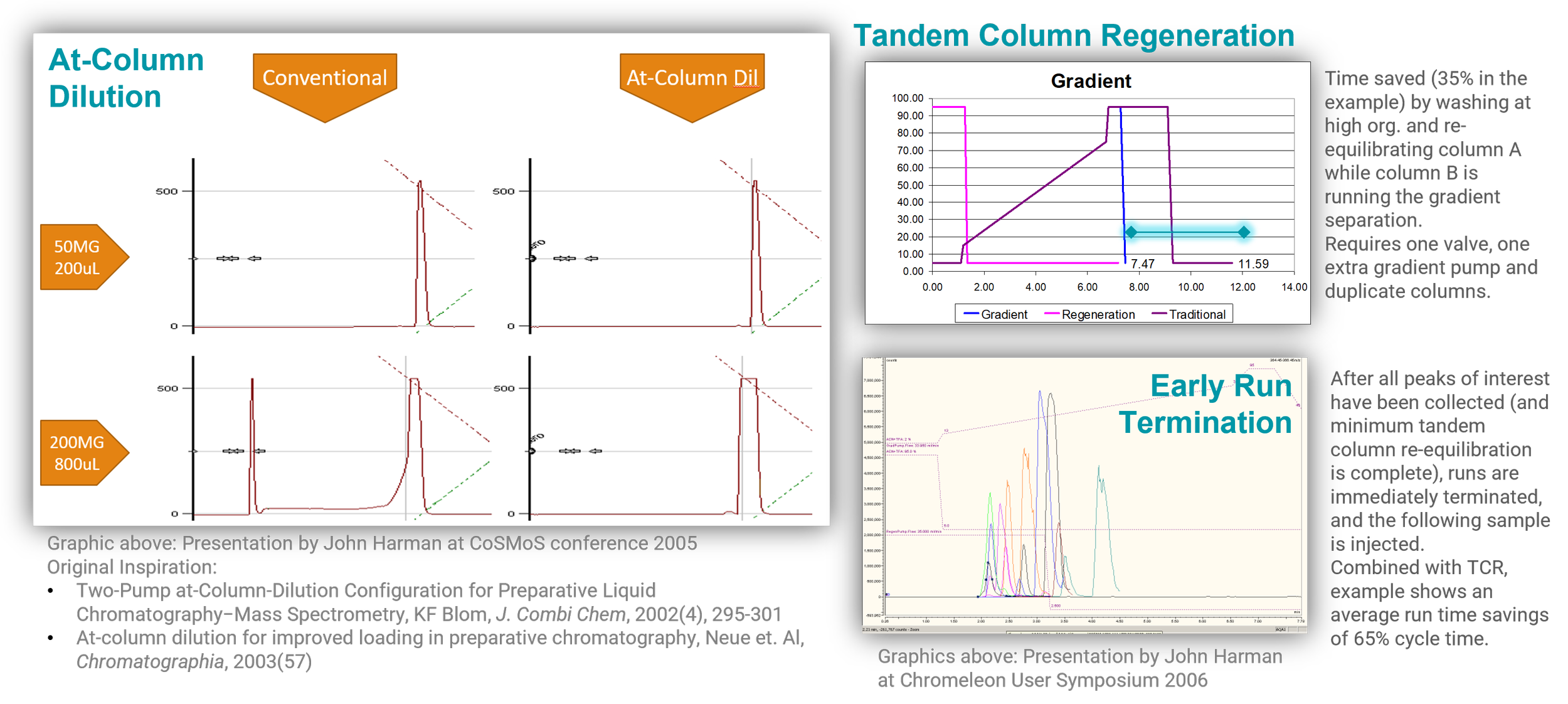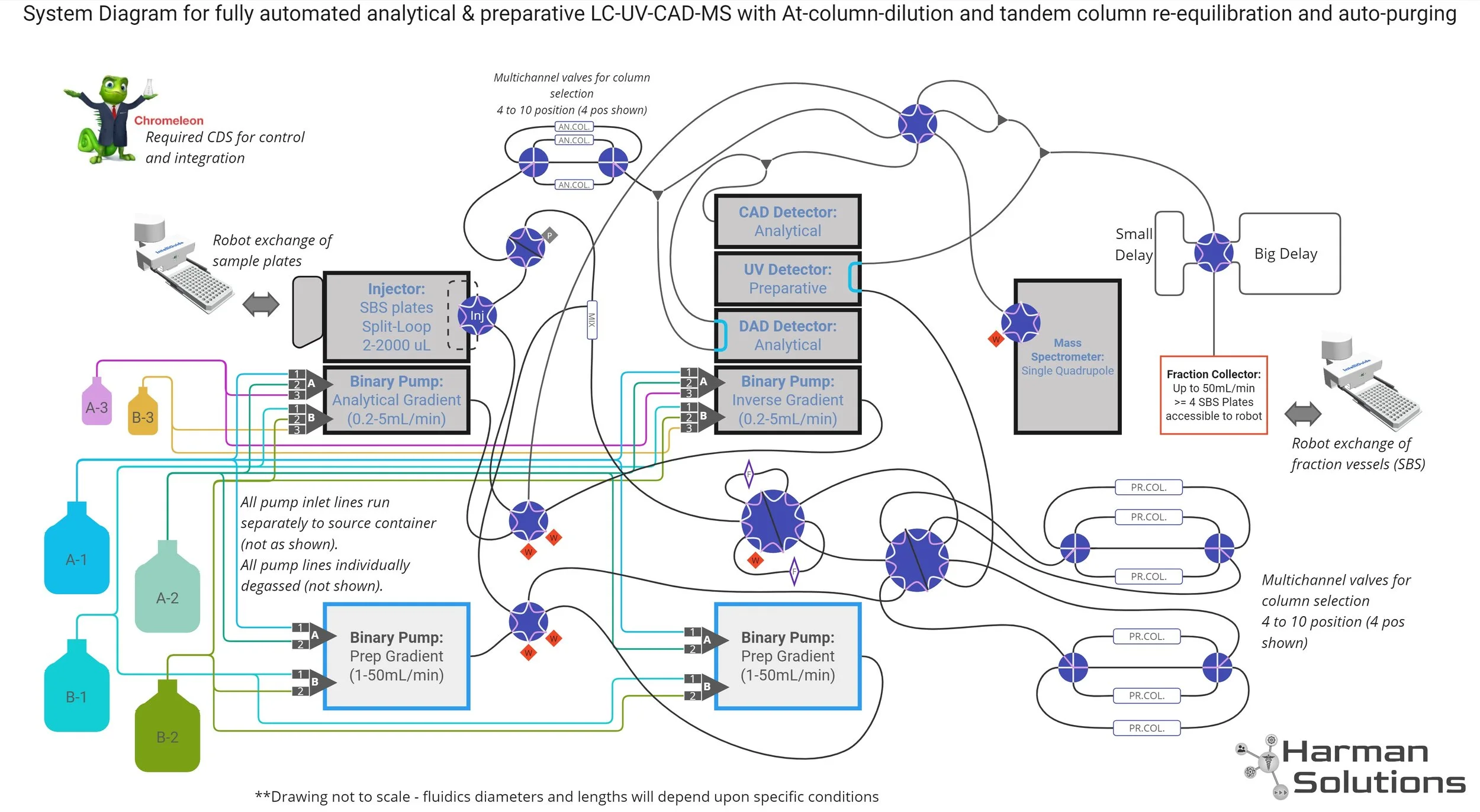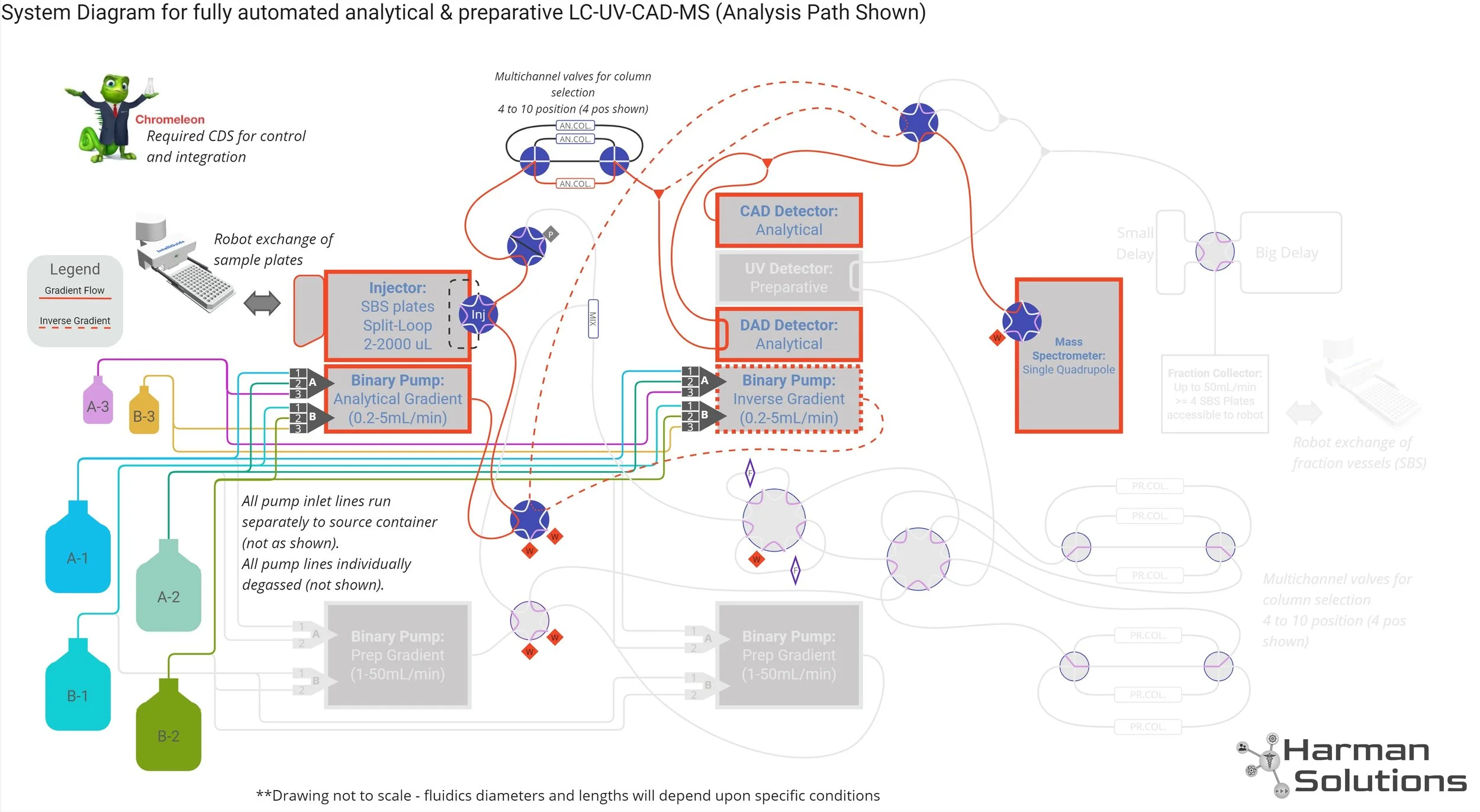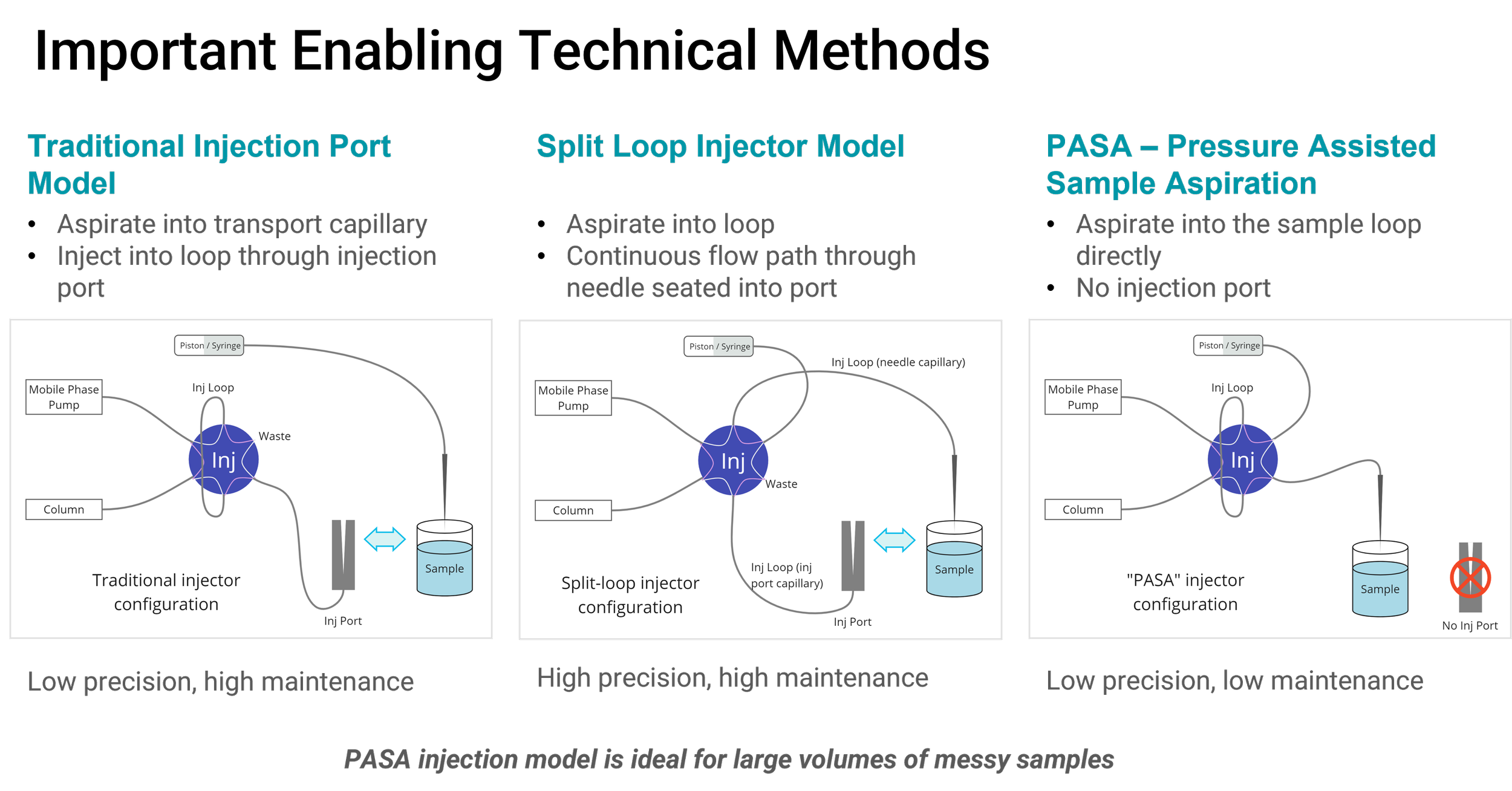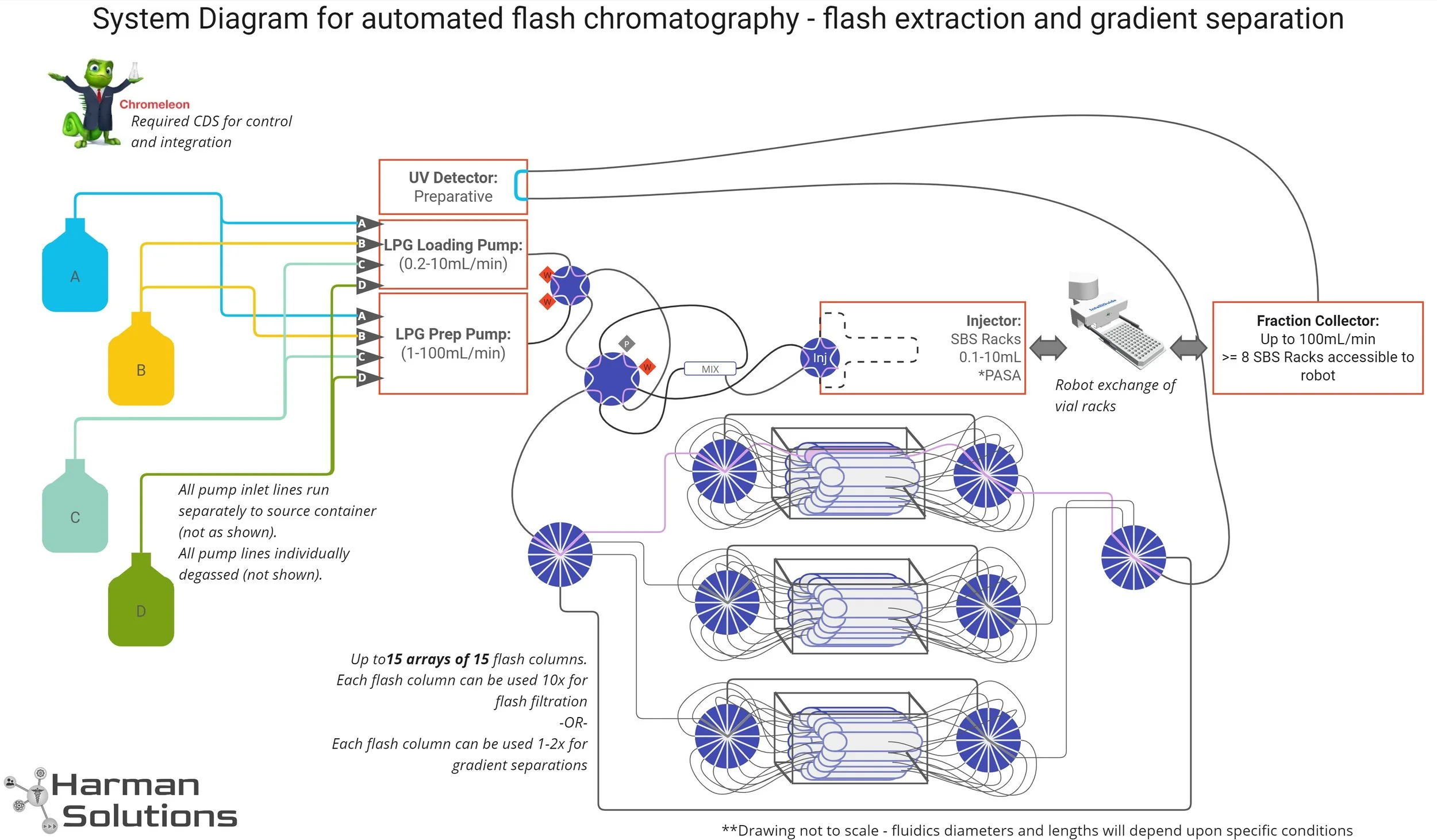Automated Liquid Chromatography
Best Practices and Innovations for Fully Automated Small Molecule LC
Available in presentation (PDF) file here for downloading and sharing.
"Product Scale" Analysis & Purification
"Intermediate Scale" Purification
Final QC Analysis
"Product Scale" Analysis & Purification "Intermediate Scale" Purification Final QC Analysis
Table Stakes for Automation
-
The system operates on-demand without human intervention
Human intervention occurs at convenient times and does not disrupt on-demand system execution
-
Sample / Sequence Data IN
Start / Stop / Observability
Sample Raw Data and Results OUT
-
Samples IN & OUT
Fractions OUT
-
Wide variety of unknown samples
Low failure / intervention rate (< 0.2%)
Resource Pooling – parallelism and fail-over protection
Opinions and Advice
The opinions and detailed system designs presented below are vendor agnostic - there is NO element of marketing, promotion, or relationship prioritization between Harman Solutions and ANY vendor including those in the space of analytical instrumentation.
That said, some specific products are identified in the materials below where there is ONLY ONE commercial option available with the required capabilities for the most robust and efficient fully automated chromatography systems. Where a product is specified, it is not opinion, but facts derived from extensive due diligence on all hardware and software systems available commercially.
Don’t make (and purify) material you don’t know you need
Purification costs more and takes longer as scale increases (even with optimized systems), leaving you the ultimate choice to reduce quality or throughput
The better option is to scale down synthesis – but using automated synthesis with well defined, reproducible synthetic routes and retaining intermediates, scale up can be done AFTER test results justify the effort
Analyze it before you purify it
Knowledge gained from analyzing your reaction outcomes are necessary to improve automated synthetic methods
Time spent on analysis will be gained in things NOT purified by implementing automated, data driven sample triage within your lab orchestration software
Use analysis data to set injection volumes, collection trigger mechanism, collection thresholds, fraction volumes, peak counts, select methods
Do the analysis and purification for the same sample on the same system whenever possible to reduce movements and system to system variability in hardware, mobile phases, communications
Don’t treat every sample as an exception
Eliminate work-up and sample prep where possible (e.g. extraction) with robust chromatography system configurations
Focus on identifying exceptions rather than treating everything as an exception (e.g. NMR analysis) after you have generated test data to justify the effort
“wasting resources more efficiently” – decreasing cost or improving capacity to produce unnecessary material will remain unnecessary
“Final Product Scale” Analysis and Purification
System design optimized for fully automated DMTA at scales of 3 - 100mg or 0.006 - 0.2mMol
System Design Objectives
Analysis of crude reaction mixtures of any scale and concentration and at any time-points of chemical reactions (pre-reaction, mid-reaction samples, post-reaction, post-workup)
Isolation (purification | extraction) of one or more specific molecules from a crude mixture with maximum yield and purity in minimum time
System Solution Design
Reverse-phase LC-MS with combined analysis and purification capabilities and sample quantitation
Important Enabling Technical Methods
At-column dilution flow path configuration and tandem column regeneration are hardware and plumbing configurations while and early run termination is entirely a chromatography software capability.
System Design
Note the critical elements: (4) different pumps running various independent gradients. Purge valves configured to enable mobile phase purging by system control software. Multiple columns can be selected to meet a variety of samples. A selection valve to “turn-off” at-column-dilution for analytical runs and “turn-on” at-column dilution for preparative runs.
The analytical flow path features some critical technical details: An inverse gradient pump for post-column isocratic flow to Charged Aerosol Detector for “universal” (structure agnostic) sample concentration measurement.
The preparative flow path features these key technical details: Tandem column regeneration using a second gradient pump and identical column sets. Dedicated preparative UV detector to minimize flow splitting. Two fraction collection delay loop sizes to accommodate different flow rates. Tunable strong solvent for at-column-dilution injection and automated injection clog resolution using the analytical pump. Inline pre-column filters with automated switching and reverse flushing.
“Intermediate Scale” Purification
System concept is designed for sample scales of 0.1 - 5.0 g per purification
System Design Objectives
Extract reaction products from crude reaction mixtures and solvents so they can be used in subsequent reaction steps
Isolation (purification | extraction) of one or more specific molecules from a crude mixture with sufficient purity and yield for use in subsequent reaction steps
System Solution Design
Normal-phase serial flash chromatography system
A Novel Use of Technology You Use Every Day
Every chemistry lab uses Flash Chromatography today; however, systems have been designed and sold to replace “TLC Plates” and “Silica Gel Columns” in your hoods. Thus, while the example hardware systems shown above are not suitable for fully automated flash purification of intermediates, the simple ways in which we use them are perfect for wide ranging scale of highly variable samples (many chemical reactions).
The configuration of autosampler injection is typically little more than a bullet on a device spec sheet. There are critical needs for fully automated systems to be robust and reliable when sampling difficult samples which have not been pre-treated. For a fully automated flash chromatography system, PASA (a.k.a. “portless”) injection is required.
System Design
NOTE: The following design has never been built (that we know of). While it is simple in concept and uses common existing technology and methods in a novel way, someone will have to be the first…
This novel automated flash system design includes the following important technical features: 15 banks of 15 flash columns for multi-day operations without human intervention. These flash column arrays can be easily removed and replaced with asynchronous human replenishment of column arrays. Injection using the PASA configuration (this will limit your injector options). At-column-dilution for maximum sample loading and injection reliability.
Final QC Analysis
System Design Objectives
Verify (not elucidate) the structure of target molecules
Measure target molecule purity
Measure quantity of target molecule
Orthogonal separation conditions from purification / isolation
System Solution Design
Reverse phase UPLC-HRMS system with Charged Aerosol Detection
Important Technical & Tactical Details
Charged Aerosol Detection
References list (Thermo Fisher Scientific)
Calibrate using different molecules with different hydrophobic index at multiple concentrations (weight conc – e.g. mg/ml) using a standard gradient
Accurate quantitation requires an inverse gradient post-column to ensure that the molecules analyzed in the detector are measured under isocratic conditions
A correction factor can be applied using a quadratic fit factoring in additional chemical properties (area of ongoing research)
Absolute error ranges from 10-20%; however, this is far lower than weighing small amounts of material with assumed salt stoichiometry (typically closer to 30% error) and negligible for early stage primary assay error rates.
Daily calibration runs are recommended, which can be fully automated and incorporated into Preparative LC recovery verification workflows of your fully automated DMTA platform
High Resolution Mass Spectrometry
Exact mass and isotope patterns differentiate between all non-identical molecular formulae and most structural isomers
When coupled with separation conditions orthogonal to the method of purification (e.g., high pH v. low pH), the precision of HRMS provides sufficient confidence in molecular identity verification to eliminate NMR as a primary sample workflow
Requires occasional calibration, which may or may not be automated depending upon choice of MS instrument; however, daily verification of exact mass accuracy can be executed during frequent CAD calibration and Preparative LC recovery runs
System Design
Of all system designs within this article, this is the least impressive. The “manual” version of this should be common in most labs, so little adaptation is necessary for integration as part of a fuly automated system. Although the CDS has been identified here because it will make the implementation and operation much easier (and as such highly recommended), it is possible to operate this system design with other CDS systems. Important technical details for this system: Charged Aerosol Detection; reverse gradient merging is post-column but pre-UV and CAD detector to facilitate additional UV and CAD data validation mechanisms; automated purge valve particularly required for automated switching between high and low pH mobile phases, and multiple columns to provide options to ensure you have orthogonal final separation.
Concluding Comments
These opinions, tactics and system designs are intended to assist you in overcoming some of the significant challenges in fully automated chromatography. Many of the technical approaches, however, can be equally beneficial (robustness, efficiency) for the semi-automated and stand alone systems you use in your labs today.
Everything you have read here can be reproduced, modified, commercialized and otherwise used freely. It is not published in a proper journal because I do not believe in restricting access to important ideas our industry needs to accelerate.

